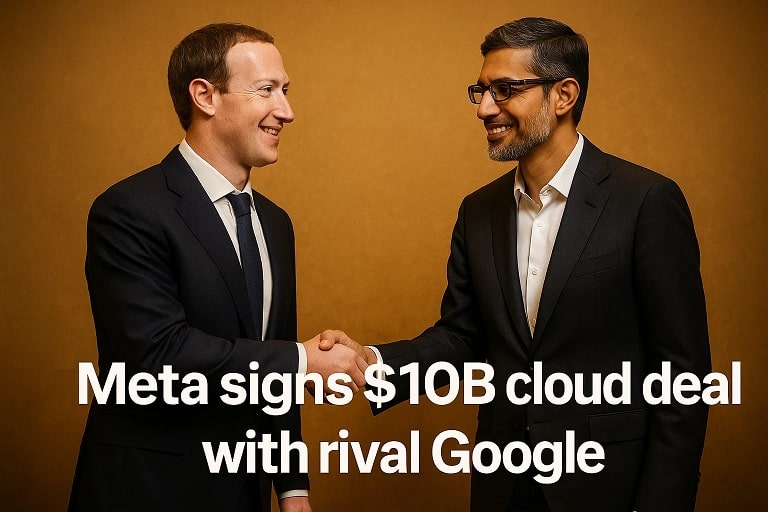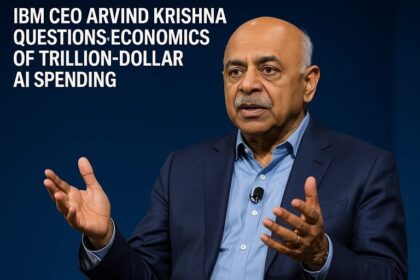Meta Signs $10 Billion Cloud Deal with Rival Google: A Strategic Move in the AI Race
By Editorial Desk | August 22, 2025
In a surprising turn of events, Meta Platforms Inc. has inked a landmark cloud computing deal with Alphabet Inc.’s Google, valued at over $10 billion, to bolster its artificial intelligence (AI) infrastructure. Announced on August 21, 2025, the six-year agreement marks a significant collaboration between two tech giants traditionally seen as rivals in the online advertising space.
Meta will leverage Google Cloud’s servers, storage, networking, and other services to support its ambitious AI initiatives, including the development of the Llama family of models. This move underscores the escalating race among tech giants to secure computing power for AI-driven innovation. This article provides a detailed analysis of the deal, its context, implications, and supporting data in tables, concluding with answers to frequently asked questions.
Overview of the Meta-Google Cloud Deal
The $10 billion-plus deal, first reported by The Information and confirmed by Reuters, positions Google Cloud as a key partner in Meta’s AI strategy. Under the agreement, Meta will utilize Google Cloud’s infrastructure to enhance its computing capacity, crucial for powering AI tools across its platforms, including Facebook, Instagram, WhatsApp, and Threads. The deal follows Meta CEO Mark Zuckerberg’s July 2025 statement that the company plans to invest “hundreds of billions” in building massive AI data centers.
With Meta offloading $2 billion in data center assets to fund this expansion, the partnership with Google reflects a strategic shift to external cloud providers to meet its growing computational needs. The agreement, spanning six years, highlights Google’s growing traction in the cloud market, where it competes with Amazon Web Services (AWS) and Microsoft Azure.
Meta’s AI Push and Cloud Rivalry
Meta and Google have long been competitors in online advertising, with Meta’s platforms (3.98 billion monthly active users in 2023) generating 97.5% of its revenue from ads. However, Meta’s pivot to AI, particularly through its Llama models, has strained its internal infrastructure. In June 2025, Reuters reported that OpenAI also turned to Google Cloud to meet similar capacity demands, signaling a trend among AI hyperscalers. Meta’s $114–$118 billion expense forecast for 2025, driven by AI infrastructure and talent, underscores the need for external partnerships.
Google Cloud, which reported $13.6 billion in revenue and $2.83 billion in operating income in Q2 2025 (32% growth), has been gaining ground on AWS and Azure. Its recent wins, including deals with OpenAI and now Meta, highlight its appeal for AI workloads, bolstered by its Tensor Processing Units (TPUs) and Gemini models. The Meta deal marks a departure from its reliance on AWS and Azure, reflecting a pragmatic move to diversify cloud providers despite competitive tensions.
Detailed Breakdown of the Deal
Key Terms
- Value: Over $10 billion, with a minimum commitment of $10 billion over six years.
- Scope: Meta will use Google Cloud’s servers, storage, networking, and other services to support AI data centers.
- Duration: Six-year agreement, starting August 2025.
- Purpose: To enhance Meta’s AI infrastructure for developing and deploying models like Llama, integrating AI across its platforms.
Strategic Objectives
- Meta’s Goals: Accelerate AI development, reduce reliance on internal data centers, and meet investor demands for AI-driven returns.
- Google’s Goals: Strengthen Google Cloud’s market position, leveraging its TPUs and Gemini models to attract AI-focused clients.
- Mutual Benefit: The deal bypasses competitive ad market tensions, focusing on infrastructure to fuel Meta’s AI ambitions.
Market Reaction
- Stock Impact: Post-announcement, Meta (Nasdaq: META) and Google (Nasdaq: GOOGL) saw modest after-hours gains of 1–2% on August 21, 2025.
- Industry Sentiment: Posts on X praised Google Cloud’s growing prowess in AI workloads, with one user noting, “GCP is becoming really, really good at handling AI workloads, enough for Zucks to go with them over competitors.”
Trends and Implications
Strategic Rationale
The deal reflects the intense competition in AI, where access to computing power is a bottleneck. Meta’s $2 billion data center asset offload and reliance on external cloud providers signal a shift from building proprietary infrastructure to leveraging scalable solutions. For Google, the deal is a coup, reinforcing its cloud unit’s 32% growth and positioning it as a leader in AI infrastructure. The collaboration, despite ad market rivalry, highlights pragmatism in the face of AI’s capital-intensive demands.
Industry Trends
- AI Hyperscalers: Meta, OpenAI, and others are investing heavily in AI, with cloud providers like Google benefiting from the demand for compute resources.
- Cloud Market Dynamics: Google Cloud’s gains (e.g., OpenAI, Meta deals) challenge AWS and Azure’s dominance, with TPUs offering a competitive edge.
- Coopetition: Tech giants are increasingly collaborating on infrastructure while competing in end-user services, as seen with Meta’s use of AWS, Azure, and now Google Cloud.
Challenges
- Cost: Meta’s $10 billion commitment adds to its $114–$118 billion 2025 expense forecast, raising investor scrutiny over AI returns.
- Dependency: Relying on a rival’s infrastructure could pose strategic risks for Meta, especially if Google prioritizes its own AI models.
- Regulatory Risks: Antitrust concerns in the U.S. and EU, given Meta and Google’s market dominance, could invite scrutiny.
- Execution: Integrating Google Cloud’s services with Meta’s AI stack requires seamless technical coordination.
Future Projections
The deal could pave the way for deeper Meta-Google collaboration, potentially extending to joint AI research or shared infrastructure projects. Google Cloud may secure more hyperscaler contracts, aiming to surpass Azure’s market share by 2028. For Meta, the partnership could accelerate Llama model advancements, though recent criticism of Llama 4’s performance suggests challenges ahead. If successful, Meta’s AI integration could boost user engagement across its 3.98 billion-user platforms by 2026.
Meta-Google Cloud Deal Snapshot (August 2025)
Metric | Value | Details |
|---|---|---|
Deal Value | >$10B | Minimum $10B over six years |
Duration | 6 years | Starting August 2025 |
Services | Cloud infrastructure | Servers, storage, networking, TPUs |
Meta’s 2025 Expenses | $114–$118B | Driven by AI infrastructure, talent |
Google Cloud Q2 Revenue | $13.6B | 32% growth, $2.83B operating income |
Key Cloud Deals in AI Race (2025)
Company | Cloud Provider | Deal Value | Purpose |
|---|---|---|---|
Meta | Google Cloud | >$10B | AI infrastructure for Llama models |
OpenAI | Google Cloud | Not disclosed | Compute capacity for AI models |
Meta | AWS, Azure | Ongoing | Existing cloud infrastructure support |
xAI | Oracle Cloud | $10B+ | AI model training (e.g., Grok) |
FAQs
What is the Meta-Google cloud deal about?
Meta signed a six-year, over $10 billion deal to use Google Cloud’s servers, storage, and networking for AI infrastructure, particularly for Llama models.
Why did Meta choose Google Cloud?
Meta needs scalable computing power for AI, and Google Cloud’s TPUs and infrastructure offer a competitive solution, despite their ad market rivalry.
How does this impact Meta’s AI strategy?
The deal supports Meta’s $114–$118 billion 2025 investment in AI data centers, aiming to enhance Llama models and AI features across its platforms.
Are Meta and Google rivals?
Yes, they compete in online advertising (Meta: 97.5% ad revenue), but the deal focuses on cloud infrastructure, bypassing direct competition.
What is Google Cloud’s market position?
Google Cloud, with $13.6 billion in Q2 2025 revenue (32% growth), is gaining on AWS and Azure, bolstered by deals with Meta and OpenAI.
How did the market react?
Meta and Google stocks rose 1–2% in after-hours trading on August 21, 2025, with positive sentiment on X about Google Cloud’s AI capabilities.
What are the risks for Meta?
High costs, dependency on a rival, and potential regulatory scrutiny could challenge the partnership’s success.
How does this compare to other cloud deals?
Similar to OpenAI’s Google Cloud deal and xAI’s $10 billion Oracle deal, it reflects the AI race’s demand for external compute resources.
Will this affect Meta’s platforms?
Enhanced AI infrastructure could improve user experiences on Facebook, Instagram, and WhatsApp by 2026, if Llama models succeed.
What’s next for Meta and Google?
Meta may deepen AI investments, while Google Cloud aims to secure more hyperscaler contracts, potentially reshaping the cloud market by 2028.













